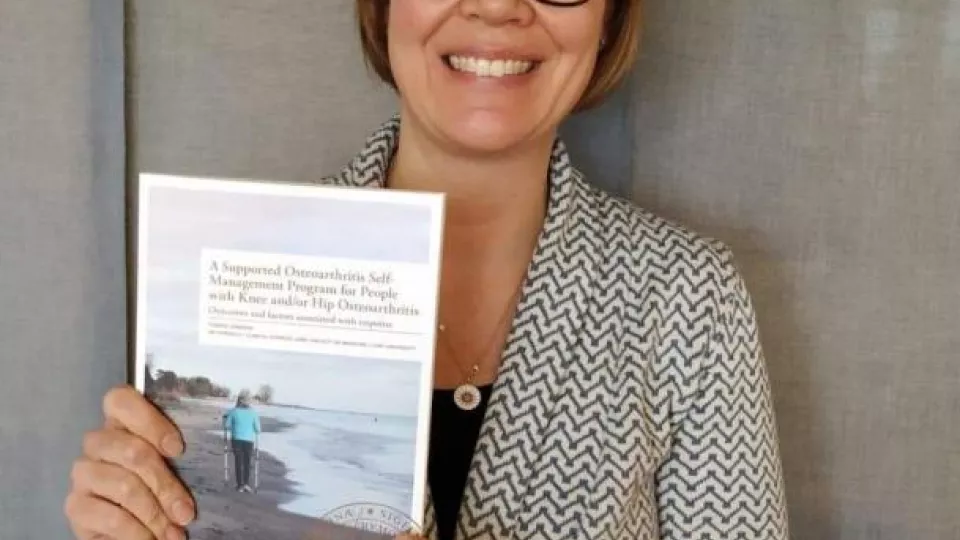Osteoarthritis can affect anyone, and becomes more common after the age of 40. The most common risk factors for osteoarthritis are heredity, obesity, previous joint damage and physically demanding work.
For over ten years, physiotherapists and occupational therapists in primary care have been trained to treat osteoarthritis patients in so-called “osteoarthritis schools”. The focus is on training and information, as well as weight loss (when necessary). In parallel, this treatment has been evaluated via a register. In her thesis work, physiotherapist Thérése Jönsson has examined the cases of nearly 45,000 registered patients with knee and/or hip osteoarthritis: has the treatment helped them, and if so, to what degree? It is already known that exercise and information alleviate symptoms for patients with knee and/or hip osteoarthritis. But the results of the health centre-based schools (of which there are more than 500 in Sweden) have been unclear. Thérése Jönsson compared patients’ osteoarthritis problems prior to attending osteoarthritis school with how they felt three and twelve months after treatment, respectively.
“In our study, we saw that school leads to decreased osteoarthritis symptoms. Pain decreased and health-related quality of life increased. Fewer people took medication, fewer people were on sick leave, and fewer people were afraid of physical activity. There were also fewer people who wanted surgery,” says Thérése Jönsson.
The next sub-study focused on pain. Did the parts of the treatment undergone by the patients have any bearing on the severity of the pain they experienced? Three patient groups were compared: patients who only underwent the theoretical portion, patients who had participated in the theoretical portion plus home training, and those who received theoretical schooling plus supervised training in groups. A comparison was also made between the perceived pain reduction in patients with hip osteoarthritis and those with knee osteoarthritis.
“The results indicated that the patients who participated in the training portion – whether at home or in a supervised group – experienced a greater pain reduction compared to those who only underwent the theoretical schooling. And the people with knee osteoarthritis experienced better pain relief than those with hip osteoarthritis.”
The thesis also examines which patients have achieved the best pain reduction through their participation in osteoarthritis school. Patients who did not have very frequent pain prior to the treatment, who did not express a desire for surgery prior to their participation, who only had osteoarthritis in one knee or one hip, and who did not suffer from obesity had a higher chance of achieving reduced osteoarthritis-related pain.
On the other hand, the osteoarthritis school does not appear to encourage physical activity. In one clinical study comparing patients who attended osteoarthritis schools with patients who did not, the results indicate that neither sedentary behaviour nor moderate physical activity were affected by the school. According to Thérése Jönsson, this may demonstrate how difficult it is to change people’s lifestyles and behaviour.
“Within the group, comorbidity in the form of cardiovascular disease, high blood pressure and diabetes is common. Therefore, we need to focus more on overall health interventions, and not just think ‘knee’ or ‘hip’. We also see a need improve implementation of the guidelines for osteoarthritis throughout the country, so that patients receive equal care and treatment. And we need to find strategies to help patients change their lifestyles and behaviours - and embrace exercise and physical activity,” says Thérése Jönsson.
Thérése Jönsson defended her thesis on the subject of nursing science specialising in physiotherapy on March 20.
Link to the thesis, A Supported Osteoarthritis Self-Management Programme for People with Knee and/or Osteoarthritis. Outcomes and factors associated with response: https://portal.research.lu.se/portal/en/publications/a-supported-osteoarthritis-selfmanagment-program-for-people-with-knee-andor-osteoarthritis(67c76b88-82d9-4b0c-b279-39745f4b77b3).html
Contact Thérése Jönsson: 070-3360721, therese [dot] jonsson [at] med [dot] lu [dot] se
